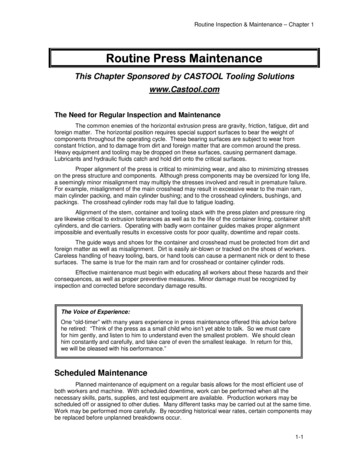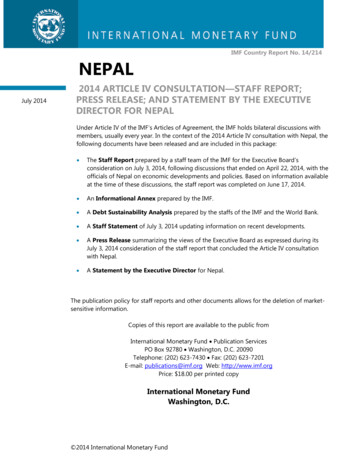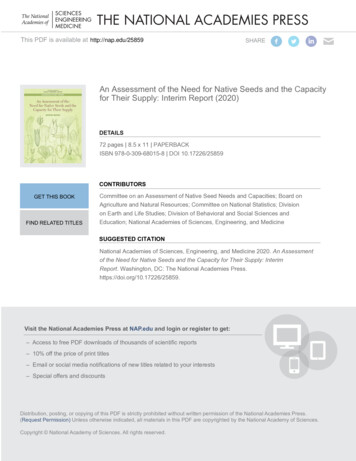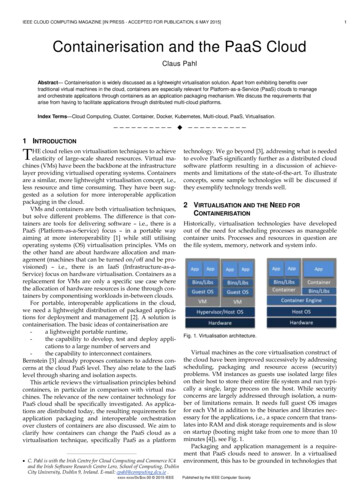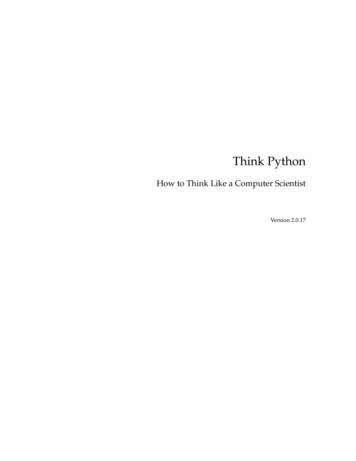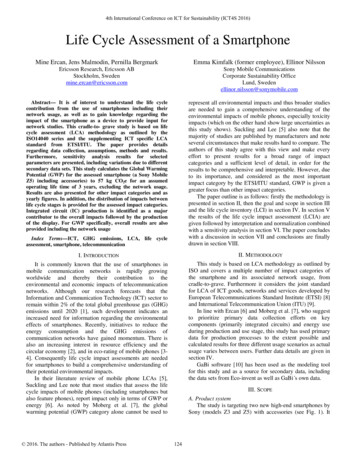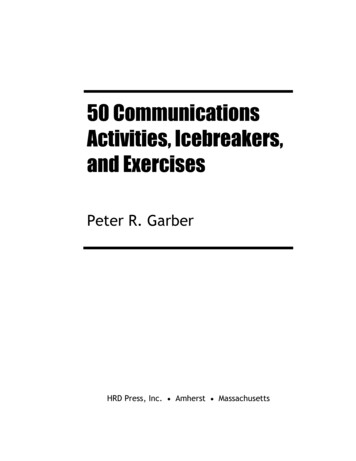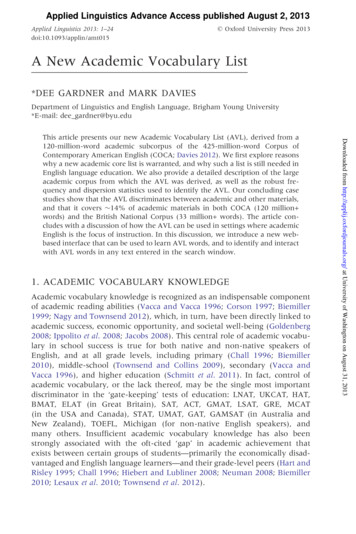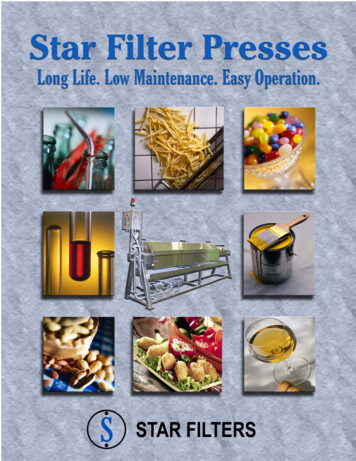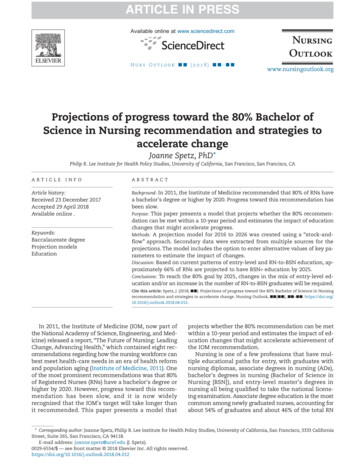
Transcription
ARTICLE IN PRESSAvailable online at www.sciencedirect.comNurs Outlook (2018) – www.nursingoutlook.orgProjections of progress toward the 80% Bachelor ofScience in Nursing recommendation and strategies toaccelerate changeJoanne Spetz, PhD*Philip R. Lee Institute for Health Policy Studies, University of California, San Francisco, San Francisco, CAARTICLEINFOArticle history:Received 23 December 2017Accepted 29 April 2018Available online .Keywords:Baccalaureate degreeProjection modelsEducationABSTRACTBackground: In 2011, the Institute of Medicine recommended that 80% of RNs havea bachelor’s degree or higher by 2020. Progress toward this recommendation hasbeen slow.Purpose: This paper presents a model that projects whether the 80% recommendation can be met within a 10-year period and estimates the impact of educationchanges that might accelerate progress.Methods: A projection model for 2016 to 2026 was created using a “stock-andflow” approach. Secondary data were extracted from multiple sources for theprojections. The model includes the option to enter alternative values of key parameters to estimate the impact of changes.Discussion: Based on current patterns of entry-level and RN-to-BSN education, approximately 66% of RNs are projected to have BSN education by 2025.Conclusions: To reach the 80% goal by 2025, changes in the mix of entry-level education and/or an increase in the number of RN-to-BSN graduates will be required.Cite this article: Spetz, J. (2018, ). Projections of progress toward the 80% Bachelor of Science in Nursingrecommendation and strategies to accelerate change. Nursing Outlook, ( ), – . https://doi.org/10.1016/j.outlook.2018.04.012.In 2011, the Institute of Medicine (IOM, now part ofthe National Academy of Science, Engineering, and Medicine) released a report, “The Future of Nursing: LeadingChange, Advancing Health,” which contained eight recommendations regarding how the nursing workforce canbest meet health-care needs in an era of health reformand population aging (Institute of Medicine, 2011). Oneof the most prominent recommendations was that 80%of Registered Nurses (RNs) have a bachelor’s degree orhigher by 2020. However, progress toward this recommendation has been slow, and it is now widelyrecognized that the IOM’s target will take longer thanit recommended. This paper presents a model thatprojects whether the 80% recommendation can be metwithin a 10-year period and estimates the impact of education changes that might accelerate achievement ofthe IOM recommendation.Nursing is one of a few professions that have multiple educational paths for entry, with graduates withnursing diplomas, associate degrees in nursing (ADs),bachelor’s degrees in nursing (Bachelor of Science inNursing [BSN]), and entry-level master’s degrees innursing all being qualified to take the national licensing examination. Associate degree education is the mostcommon among newly graduated nurses, accounting forabout 54% of graduates and about 46% of the total RN* Corresponding author: Joanne Spetz, Philip R. Lee Institute for Health Policy Studies, University of California, San Francisco, 3333 CaliforniaStreet, Suite 265, San Francisco, CA 94118.E-mail address: joanne.spetz@ucsf.edu (J. Spetz).0029-6554/ — see front matter 2018 Elsevier Inc. All rights .012
ARTICLE IN PRESS2Nurs Outlook (2018) – workforce in 2016 (National Council of State Boards ofNursing [NCSBN], 2017; U.S. Census Bureau, 2017). Since1964, the American Nurses’ Association has advocatedthat all RNs be required to have a BSN (Dillon, 1997; Friss,1994; Institute of Medicine, 2011), and in the mid1990s the National Advisory Council on Nurse Educationand Practice encouraged policy actions to achieve aminimum of 66% of RNs having a BSN degree or higherby 2010 (Aiken, Cheung, & Olds, 2009; Altmann, 2011).The 2011 IOM recommendation echoed these priorguidelines, referring to a growing body of research thatlinked higher levels of RN education with better patientoutcomes in acute-care settings (Aiken, Clarke, Cheung,Sloane, & Silber, 2003; Estabrooks, Midodzi, Cummings,Ricker, & Giovannetti, 2005; Friese, Lake, Aiken, Silber,& Sochalski, 2008; Kendall-Gallagher, Aiken, Sloane, &Cimiotti, 2011; Tourangeau et al., 2007; Van den Heedeet al., 2009).Increases in the share of RNs with BSN and highereducation can result from two trends. First, entrylevel graduates could shift from AD and Diplomaprograms to BSN and entry-level master’s degree programs, thus increasing the numbers of newly licensedRNs with a BSN degree or higher. There has been sucha trend, with an increase in the share of BSN and higherdegrees among first-time National Council Licensure Examination (NCLEX) takers from 39.3% in 2010 to 46.2%in 2016 (NCSBN, 2017). Second, greater numbers of ADor diploma-educated RNs could pursue a BSN after licensure. This also is occurring; the number of RNsgraduating from BSN completion programs has morethan tripled from 19,606 in 2009 to 60,842 in 2016(American Association of Colleges of Nursing [AACN],2010–2017).Despite the shift of entry-level education toward theBSN and growth in RN-to-BSN graduations, only 54.4%of all RNs had a BSN degree or higher in 2016 (Campaignfor Action, 2017). Attainment of the 80% target by2020 will not occur, even though there have beenmultipronged efforts nationwide to advance RN education (Academic Progression in Nurisng [APIN], 2017)and a growing number of employers prefer to hire BSNeducated RNs (AACN, 2014). Projections of the currenttrajectory and analysis of the potential impact of different strategies are needed to guide future investmentsto accelerate progress.DataDataSecondary data were extracted from the American Community Survey (ACS), which is an annual surveyconducted by the U.S. Census Bureau to describe thepopulation of states and the nation (U.S. Census Bureau,2017). The ACS asks respondents to report their highestlevel of education overall and, if they have a bachelor’sdegree or higher, to report their field of study for theirbachelor’s degree. RNs were identified as “BSN ” if theirhighest degree was a bachelor’s degree with a nursingmajor or a graduate degree with any bachelor’s degreemajor. BSN nurses thus include RNs whose nursing education might not include a bachelor’s degree but whohave a graduate degree and work as an RN. The numbersof RNs with BSN and other education were calculated in 10-year age groups from the ACS for the nationand each state. In addition, state websites were searchedto identify whether state-level organizations reporteddata from their own surveys about RN education levels;these data were used if the data were more recent orhad a smaller margin of error than the ACS.The number of new entrants to the nursing profession was estimated from NCSBN reports on the numberof first-time NCLEX-RN takers, by type of degree (NCSBN,2017). The number of graduates of RN-to-BSN programs was provided by the AACN (AACN, 2010–2017).These data sources do not provide information aboutthe age distribution of test-takers and graduates. Datafrom the California Board of Registered Nursing 2015–2016 Annual Schools Survey were used to obtain the agedistribution of graduates of AD and of BSN programs(Blash, Shinoki, & Spetz, 2017). Data from the California Board of Registered Nursing Survey of RN EducationExperiences were used to estimate the age distribution of graduates from RN-to-BSN programs (Spetz, Chu,Blash, Lin, & Keane, 2014).MethodsA projection model was created using a “stock-andflow” approach (Bruni, 1988). The “stock” is the numberof RNs available and the “flows” are RNs moving intoand out of the stock. Figure 1 illustrates the model usedfor this study. There are stocks of BSN RNs (pink ovals)and other RNs (green ovals) in 10-year age groups. Theinflows are newly licensed RNs who can enter any ofthe education-age groups, indicated by the orange boxesand arrows. The outflows are RNs moving into older agegroups or leaving the labor market from the oldest agegroup. RNs also can move from the non-BSN stock tothe BSN stock upon completion of post-licensure education, as indicated by the pink arrows.The model begins with 2016 data and then estimates the stocks for 2-year increments. Every 2 years,20% of each age group moves to the next age group, assuming that RNs’ ages are evenly distributed within the10-year age groups (blue arrows), and newly graduated RNs are added to the stock. For the youngest agegroup (30 years and younger), it is assumed that 40%move to the next age group every 2 years because thisage group is predominantly composed of RNs 26 to 30years old. For the oldest age group (61 years and older),it is assumed that 30% leave the labor force every 2 years,which is consistent with data used in California’s forecasts of RN supply (Spetz, 2017).
ARTICLE IN PRESSNurs Outlook (2018) – 3Figure 1 – Stock-and-flow model of the RN workforce. AD, associate degree; BSN, Bachelor of Science inNursing; RN, Registered Nurse. (Color version available online.)The calculations are iterated four times to obtain projections 10 years into the future. The projections arecomputed in an Excel workbook, which is availableonline (http://rnworkforce.ucsf.edu) and includes theoption to enter alternative values of key parameterssuch as the numbers of newly graduated nurses in eachage-education group and the number of RN-to-BSNgraduates.This model has a number of limitations. First, it doesnot model inflows of internationally educated RNs, manyof whom have bachelor’s degrees. Second, it does notinclude outflows of RNs who choose to leave the profession at younger ages or move to other countries. Third,the data from California used to estimate the age distribution of newly graduated RNs may not match thenational age distribution owing to unique characteristics of the RN education system in that state. Fourth,this model does not account for internationally educated RNs, most of whom have baccalaureate-leveleducation. Changes in rates of international recruitment may increase or diminish the overall share of RNswith a BSN. Fifth, the model assumes that RN employment is constant over RNs’ lifetimes and does not projectchanges in the stock of nurses as some choose to stopworking at various stages of their lives. The omissionof these factors was deliberate to ensure a straightforward model design, which is useful for general planningpurposes. The results should not be considered precise.FindingsIn 2016, 54.4% of RNs had a bachelor’s in nursing or graduate degree (BSN ). Based on current patterns of entrylevel and RN-to-BSN education, approximately 66% ofRNs are projected to have BSN education by 2025(Figure 2).Figure 2 – Projected percent of nurses with Bachelor of Science in Nursing or higher education.
ARTICLE IN PRESS4Nurs Outlook (2018) – Figure 3 – Projected percent of nurses with BSN or higher education if 70% of new graduates have a BSN ormaster’s degree. BSN, Bachelor of Science in Nursing.To reach the 80% goal by 2025, changes in the mixof entry-level education and/or an increase in thenumber of RN-to-BSN graduates will be required. Figure 3presents projections if the share of newly entering RNswith BSN education rises immediately from the current46% to 70%. In this scenario, nearly three quarters ofRNs would have BSN education by 2026, which is stillshort of the IOM recommendation.Another approach is to have more nurses pursue postlicensure baccalaureate education. As seen in Figure 4,if the number of RN-to-BSN graduates rose to 100,000per year, 75% of RNs would have BSN education in 2026.Figure 5 combines the scenarios presented in Figures 3and 4, with 70% of new graduates having BSN education and 100,000 RN-to-BSN graduates per year. In thisprojection, the share of RNs with BSN education wouldbe 79% in 2024 and nearly 84% in 2026.DiscussionSince the IOM Future of Nursing report, numerous additional studies have confirmed that more RNs need toattain at least a bachelor’s degree to meet future healthcare needs (Blegen, Goode, Park, Vaughn, & Spetz, 2013;Cho et al., 2015; Kutney-Lee, Sloane, & Aiken, 2013;Yakusheva, Lindrooth, & Weiss, 2014a, 2014b; You et al.,2013). In addition, employers have demonstrated a strongpreference for hiring BSN-educated nurses (AACN, 2014).Figure 4 – Projected percent of nurses with Bachelor of Science in Nursing or higher education if the numberof Registered Nursing-to-Bachelor of Science in Nursing graduates increases to 100,000 per year.
ARTICLE IN PRESSNurs Outlook (2018) – 5Figure 5 – Projected percent of nurses with Bachelor of Science in Nursing (BSN) or higher education if 70% ofnew Registered Nurse (RN) graduates have a BSN or higher degree and the number of RN-to-BSN graduatesincreases to 100,000 per year.Despite this, progress toward the IOM recommendation has been slow. More than half of entry-level RNgraduates have an AD and, while many want to obtaina BSN, there is not sufficient capacity in entry-level BSNor RN-to-BSN programs to reach the IOM recommendation in the foreseeable future.Most states are faring no better than the nation. In2016, no state had reached the 80% target; in fact, nonehad reached even 70% by 2016. Only 11 states—Alaska,Colorado, Delaware, Hawaii, Idaho, Kansas, Michigan,Minnesota, Nebraska, New Jersey, North Dakota—andthe District of Columbia have at least 60% of their RNsat the BSN level of education (U.S. Census Bureau, 2017;state-specific data obtained by author).The projection model developed for this study helpsidentify the key reasons that progress has been and islikely to remain slow toward attaining the IOM’s recommendation. The main factor affecting progress is thelarge incumbent RN workforce. There are over 3.3 millionRNs in the United States, and the 157,143 people whotook the NCLEX for the first time in 2016 are only 4.7%of the size of the total workf
Discussion: Based on current patterns of entry-level and RN-to-BSN education, ap-proximately 66% of RNs are projected to have BSN education by 2025. Conclusions: To reach the 80% goal by 2025, changes in the mix of entry-level ed-ucation and/or an increase in the number of RN-to-BSN graduates will be required. Cite this article: Spetz, J. (2018, ). Projections of progress toward the 80% .
